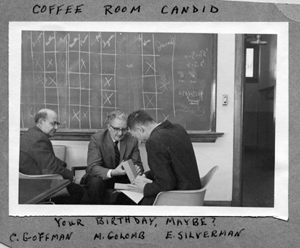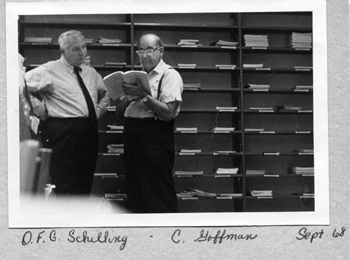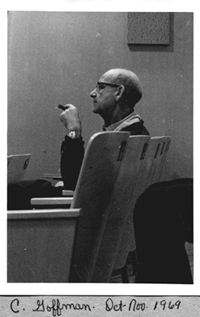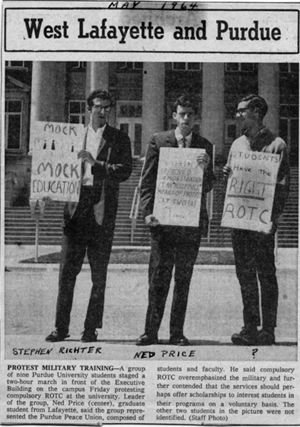|
In retrospect
Casper Goffman came to Purdue in 1957 as a visitor and never left. His research and vigilance were important in guiding the transition of the Department of Mathematics during the 60's from a largely service-oriented department to the vigorous and active group that has made Purdue an important center of mathematical research as well as service and education. Felix Haas, who served as Department Head during that period and later as Executive Vice-President (Provost), recently commented, "When I tried to attract young mathematicians here from the major centers, Goffman's reputation was a major asset." Goffman's research included Fourier analysis, potential theory, and geometric measure theory. Since receiving his doctorate in 1942, he has published in every decade up to this one! He has written several books, the most recent in 1997 with T. Nishiura and D. Waterman.
PUrview recently invited several of Cas's students and former colleagues to help capture the spirit of the Purdue Mathematics Department during those days.
Daniel Waterman, Professor Emeritus, Syracuse University
When I was a young assistant professor at Purdue, Cas Goffman came as a visiting professor from Oklahoma. I had been a student of Zygmund, and four of my first five papers dealt with complex function theory aspects of Fourier analysis rather than real analysis aspects. A good measure of the influence Cas had on me is that almost all of my work since then deals with real analysis aspects.
I found Cas's approach to mathematics very exciting. We would often spend hours walking and talking about a problem and then, the next time we met, we would begin again with exactly the last thing we had said and continue from there as if we had never stopped. When one of us had a new idea about a problem, he would get in touch with the other immediately. Once I walked into the Goffman house at 3 a.m. and woke up Cas and Eve so that I could tell him what had just occurred to me. The Goffman's didn't seem to be the least bit surprised. Eve was the most supportive and understanding of wives. To me, she was also an understanding friend.
When I left Purdue, our collaboration became more difficult. We spent a lot of time on the phone, and I would come to Lafayette to talk to him. One weekend I arrived, we quickly decided that we knew how something should be done, and then Cas and Eve went out to a party while I sat in Cas's study to write up the details. Cas told me later that people at the party asked about me and he responded, "Oh, he's at home writing our paper."
While working on what I consider to be our best joint paper, the solution of the localization problem for double Fourier series, I called Cas to tell him that I knew how to do a certain part which was necessary but not central, but I needed several pages to handle the basic special case. We talked at length about what I had done and then Cas said, "In one of my papers in the Acta, I had to do something like this and I thought of a neat trick to do it." I looked it up and found that he was absolutely correct; the same device would handle the matter in a few lines.
My collaboration with Cas occupies a large place in the center of my intellectual life. To a great extent, how I think about mathematics is a product of the collaboration. The only gift that I received from him that I value more was his friendship, which I treasure.
Richard O'Malley (Ph.D. 1972), University of Wisconsin, Milwaukee
I came to Purdue to work with Cas based on using his textbook as an undergraduate. When I arrived in late August 1967, the new Math Building had just opened and our group of TA's was the first to use the offices. The assignments were three to an office and in alphabetical order. I was in an office with Pat O'Malley and Jim Norris. We were all ecstatic about being there. Pat was a real big cornhusker type of fellow and had an easy, confident, laid-back air, totally unlike me. We spent the first few hours confirming that we had no common relatives, but over the years have still remained friends. He was always telling me "not to worry little fella." Jim was another laid-back type, originally from Hawaii. He had just come out of the Peace Corps and had worked in Africa. After he finished, he went for a vacation in Germany and used almost all his money to buy a BMW motorcycle. He drove all around Europe and then shipped himself and the bike by boat to New York, and then rode the bike to Purdue in one day. Each of us had a story. It was an exciting period. We were all different, but still the product of that U.S. push to catch up with the Soviets after Sputnik. We were all thinking about the Vietnam War and what it meant; we were all into rock and roll.
One of the people in the next room was Kyung Ho Moon, who had come from Korea (later he got his degree with Hunt). We became close friends, and it was from him that I learned the simple fact that people are basically the same all over the world. Two doors up the hall were three female TA's Judy Hutchens, Dot Hokema, and Rosemary Proctor. Rosemary and I met that first day, and we're still together.
I remember back in 1969 when Cas wanted to run a class about harmonic analysis and potential theory where several of the faculty Rao, Drasin, Hunt, etc. were the main people interested. The TA's all dropped out the first day except me, and the faculty made me do all the homework and detail filling. This was the first class where I saw practicing mathematicians struggling to work out problems. The seminar atmosphere made me feel alive and part of something bigger.
Cas yelled at me only twice that I remember. Once he was telling me about his thesis advisor Blumberg and how he proved that an arbitrary function f mapping R to R had to have a dense set D such that the restriction of f to D was relatively continuous. I made the mistake of saying that I thought that sounded like a reasonable result. He bet me $50 I couldn't prove it in 30 minutes. I was too surprised to try, but the idea fascinated me. One way of looking at my research is that I'm still trying to understand the implications of that result.
The other time he yelled was after he went off to London the summer of 1970 while I was to work on my thesis supported by his research grant. When he came back, he asked what I had done, and I responded that I had gotten married to Rosemary. I never knew whether he yelled because he missed the wedding or because he wanted me to get more done. I know that he liked Rosemary, so it wasn't that. Anyway, after he voiced his displeasure, over the next two months I went into seclusion on the ninth floor of the Math Building and proved the first two results of my thesis to get back in his good favor.
William Gorman (Ph.D. 1965), Computer Science Department, Purdue University
Some of the amenities graduate students in the Department of Mathematics enjoyed in the early sixties were keys to the Mathematics Library, air conditioning (a rarity then) on the fourth floor of the Recitation Building (then the home of the department), and the "coffee room," which was a classroom that had been converted into a lounge but served as much as an intellectual workshop where faculty and graduate students could easily interact.

Among the regulars in the coffee room, and one of the people who made that facility so valuable even a vital part of the department was Casper Goffman, then in the early years of his long tenure as a faculty member at Purdue. I do not think that he spent most of his time there, but whenever I wanted to see him, that was the first place I looked. Rarely did I meet with him in his office.
My image of him in the coffee room is not so much of a faculty member taking a break as of a first-rate mathematician happily doing mathematics with his colleagues and students. His breadth of knowledge and his generous availability made him a marvelous resource and encouragement for graduate students. As one student put it, you could ask him anything about mathematics: he would probably know the answer, and if he did not, he would have a good estimate of it.
His ready sense of humor was a source of delight, his talent commanded our admiration, and his person earned our affection.
Fon-Che Liu (Ph.D. 1968), Academica Sinica, Taipei; National Taiwan University
Although thirty some years have passed since I first came to Purdue as a graduate student in the fall of 1965, I still remember vividly and with gratitude my first days there. At that time, the Mathematics Department was in the Recitation Building, near where one finds the Mathematics Department today. Then still under the spell of shocks from cultural differences experienced in the beginning of my student life in America, I spent most of my time in the Mathematics Library, to which I could get in with a key even after regular library time. It was an extraordinarily fine Saturday morning one or two days after the orientation for the new graduate students when I first saw Professor Casper Goffman in the library in front of the shelf for new issues of journals. I could not resist observing him attentively after he had been standing there for quite awhile, browsing those newly arrived issues of journals, his face showing traits of wisdom and thoughtfulness. It was only weeks later I learned his identity after I had seen him many times in the library and in the common room of the department.
I found the common room a really pleasant place where I felt at ease and relaxed after having spent some time in the library. One would feel like a member of a family there with all those conversations, whether serious or lighthearted, going on. One could not fail to find that Professor Goffman was the main figure that kept the common room full of spirit. People liked to talk to him whether it was on mathematics, on topics of common concern, or even on personal feeling. He was often there also on Saturday mornings; actually I accidentally overheard him once explaining a very interesting point in the construction of measures of a certain type to a professor on such a morning and marveled at the way he made delicate mathematical arguments understood. This already suggested that later I should study real analysis under his supervision.
The common room of the Mathematics Department at Purdue was where I learned how to appreciate what others have done in mathematics or otherwise, and it was also where I usually met Professor Goffman when I visited Purdue for periods ranging from one year to a few days during the past 30 years. Our joint works in mathematics mostly took shape there.
Professor Goffman is more than a supervisor who guided my graduate study at Purdue. He is to me a dear friend who can read my mind and gives at the right time encouragement and advice that I treasure all my life. I would like to call him Cas, as he would have wanted me to do, but my cultural background makes it impossible for me to do so. I really feel sorry about this.
Whenever I recall my days at Purdue either as a student or as a visitor, I feel grateful and thankful for the opportunity Purdue has offered me for pursuing studies in mathematics, and I would say in my heart, "Thank you, Professor Goffman."
Togo Nishiura (Ph.D. 1959), Wayne State University
I began my studies in the fall of 1954, a green graduate student in the midst of famous and soon-to-be-famous mathematicians. Among my teachers were Cesari, Golomb, A. Rosenthal, Kemperman, Sam Perlis, Dan Waterman, Neugebauer, and Bob Williams. Rosenthal taught the real analysis course, and among the references he used were the books Set Functions by Hahn and Rosenthal and Real Functions by Casper Goffman so I knew Casper only as a reference book author in my early years at Purdue. Bob Williams introduced me to dimension theory, one of my favorite subjects.
I first met Casper in 1959 at Purdue our meeting occurred after Chris Neugebauer told me about work that he and Casper were doing. It was the beginning of our long friendship which resulted in many exciting mathematical collaborations. Our work seemed so compatible that I am often asked if Casper was my Ph.D. advisor. Actually, my advisor was Lamberto Cesari, and I completed my degree the year before I met Casper.
During my post-doctoral year as a member of the Purdue faculty, I met J. de Groot of Amsterdam and Casper Goffman. De Groot led a research seminar on dimension theory in which my earlier contact with Bob Williams bore much fruit. I would be remiss if I didn't mention other important research actiivities that were in progress during my years of study at Purdue. Cesari was writing his book on differential equations and starting his work on control theory. Gillman, Henricksen, and Jerison were writing their book Rings of Continuous Functions. J. Isbell was writing his book Uniform Spaces.
Many members of the Purdue mathematics faculty from my graduate student days have very much influenced my career. The longest lasting influence began when I met Casper, and it continues even now. Recently, Casper Goffman, Daniel Waterman, and I wrote the book Homeomorphisms in Analysis.
Graduate study in mathematics at Purdue was very exciting and rewarding more than 40 years ago, and I am sure that it is equally so today.

Clifford Weil (Ph.D. 1963), Michigan State University
Chapter 1. The Teacher
As new graduate students we were assigned to take a course in analysis from Casper Goffman at 8:00 in the morning. We had no way of knowing at the time that the choice of the hour was his and not of some vindictive administrator. He would enter the classroom each morning with three new pieces of chalk in one hand and a well-smoked cigar in the other. (Smoking in the classroom was permitted in those days.) He would place the chalk strategically along the chalkboard, pick up one, break it in half and begin his lecture. How I'd like to say that he used the cigar as a prop in much the same was as George Burns did, but George Burns never, never lit his cigar. Cas did, but only after he had written the statement of a theorem on the board. Then he would pause, strike a match, light the cigar, and take a puff or two. It now seems apparent to me that he was using the cigar ritual to formulate and outline the proof of the assertion in his mind, because after those first few puffs, he would remove the cigar from his mouth and hold it in his hand as he wrote the proof on the board. Of course, the cigar would go out.
Chapter 2. The Examinator

In those days one had to take an oral exam in order to get a Master of Science degree. My exam occurred during the third semester of my graduate studies. I prepared by reviewing all of the material covered in all of the courses I had taken and felt I was ready. Cas asked the first question. It was to state the definition of an ordered group. I had never encountered the concept and admitted as much. He said, "I know, but state the definition anyway." I guessed correctly, and he then asked me to define what a well-ordered group would be. That was easy given the first answer. Then he asked for an example of such a group. I could come up with only one example: the trivial group. He said, "If you can't find another example, what must you conclude?" I was being backed into a corner and gave the only answer I could, knowing full well what his next comment would be. I said that the trivial group is the only example, and he gave the expected response, "Prove it." He proved to me that I could think under pressure, but after getting past that, I had trouble proving that the continuous image of a compact set is compact.
Chapter 3. The Thesis Advisor
Cas gave me several papers to read; one of them suggested some very interesting problems which I tried to solve. I made some progress and then Cas went on a sabbatical leave. While he was gone I thought I had finished my thesis, but shortly before his return I found an error. When he got back Cas sat in the coffee room with me and constructed a counter example to what was the best result in my thesis. I was crushed, but he was wrong and I found a correct proof.
Epilogue.
I learned more from Cas than just mathematics. He was the best thesis advisor a young person could have.
Martin (Ned) Price (Ph.D. 1966), Framingham State College
My years at Purdue were the early years of the Vietnam conflict, and my interest in politics almost equaled my interest in mathematics. I had seen some papers of Cas while at Illinois Tech, and I had met Joel Smoller when he visited Chicago. Perhaps these papers and Smoller were responsible for my arrival in West Lafayette. The first two years of my stay, before I got to know Cas, were memorable ones because of the Cuban missile crisis and the JFK assassination. At this time a small group of us including Smoller, Terry Zachmanoglou, Harley Flanders, and Gus Wollan formed the Purdue Peace Union, a group that was not universally popular at an institution where Sen. Homer Capehart and Rep. Charlie Halleck were revered.
In my third year I began taking Cas's courses and developed some feel for the kind of mathematics he did. Cas was very patient and encouraging. I even began doing mathematics late at night. (In fact, one night at about 3 a.m. I went to the Mathematics Library and found T.T. Moh reading Pride and Prejudice in Chinese.)
Cas was always at our weekly meetings and probably was more patient than he had to be judging by his tolerance for my rabble-rousing. He seemed genuinely amused by my suggestion for ending the Cold War by everyone swearing to "take a Communist to lunch this week." Thirty-four years later the Cold War is over, and he is still around. God bless Casper Goffman!

|